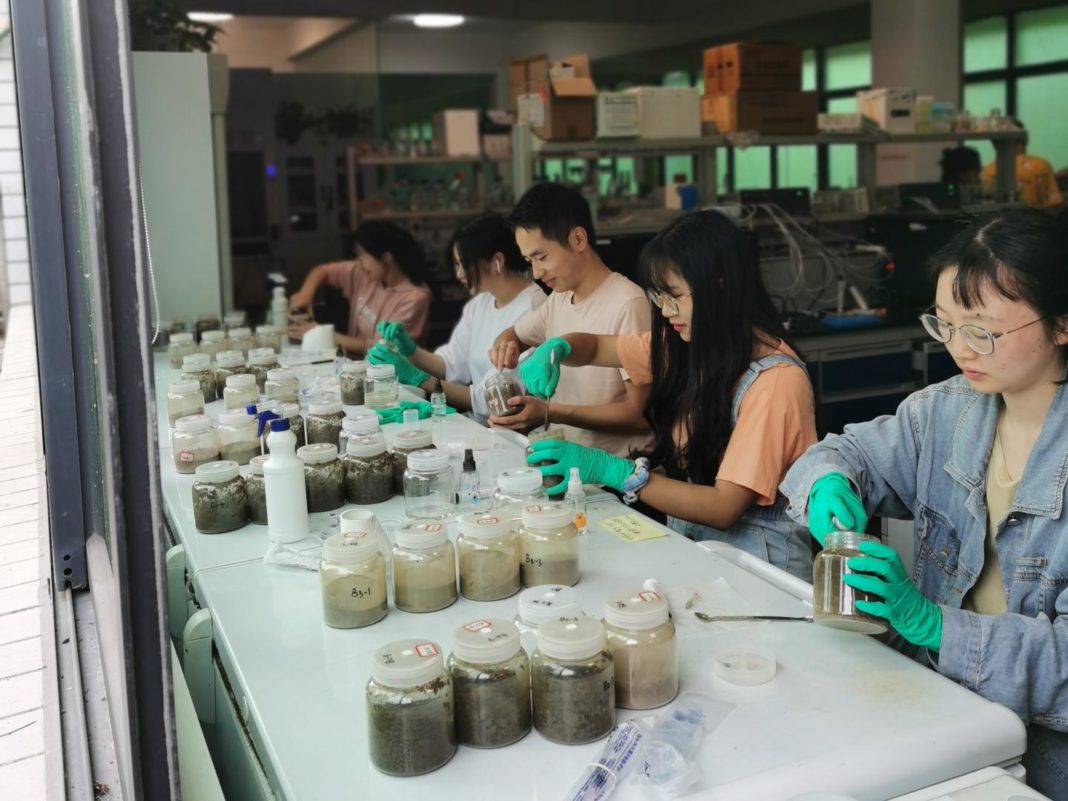Setting up soil microcosms for herbicide exposure experiment [Liao Hanpeng]
The use of three widely used weedkillers—glyphosate, glyfosinate, and dicamba—can increase the prevalence of antibiotic-resistant bacteria in soil, according to the results of a study by researchers at the University of York, and at Fujian Agriculture and Forestry University, in China. The researchers say that their results indicate that the effects of herbicide concentrations on soil microbial communities should be re-evaluated to better understand the risks associated with the spread of antimicrobial resistance in agricultural settings.
“Our results suggest that the use of herbicides could indirectly drive antibiotic resistance evolution in agricultural soil microbiomes, which are repeatedly exposed to herbicides during weed control,” commented Ville-Petri Friman, PhD, lecturer in evolutionary biology, University of York. “As resistance genes can easily move between environments, agricultural fields could be globally important source for resistance genes … While antibiotic resistance genes [ARGs] are not harmful per se, they will reduce the efficiency of antibiotics during clinical treatments. Keeping the frequency of resistance genes low will hence prolong the long-efficiency of antibiotics.”
Friman, together with Shungui Zhou, PhD, at Fujian Agriculture and Forestry University, are corresponding authors of the team’s published paper in Molecular Biology and Evolution, which is titled, “Herbicide selection promotes antibiotic resistance in soil microbiomes.”
Herbicides are one of the most widely used chemicals in agriculture and while these compounds are used to target weeds, they can cause damage to soil microbes, such as bacteria and fungi, potentially changing the ecological properties of microbial communities. “While these compounds are thought to be specific to plants, they can cause collateral damage to other types of organisms by targeting evolutionarily conserved pathways,” the authors noted. Previous studies have linked herbicide use to compositional changes in host-associated microbiomes in insects and plants, and this could also potentially change the ecology of these microbial communities and how they interact with their host species, the authors continued. “However, the potential evolutionary consequences of herbicide selection for the genetic composition and functioning of bacterial communities are poorly understood in soil microbiomes.”
For their newly reported study, the scientists carried out direct selection experiments in soil microorganisms, combined with genome sequencing and transcriptomic techniques, to study how the three herbicides, glyphosate, glufosinate, and dicamba, affect soil bacterial communities. They then carried out environmental sampling across different regions in China, to see if the patterns they observed in their lab studies were also evident at the geographical scale.
Using the soil microcosms, the researchers discovered that while herbicides had little effect on the abundance and composition of soil microbiota, exposure to these chemicals did increase the relative abundance of antimicrobial resistance genes and mobile genetic elements (MGE) in the bacterial species. The results indicated that mutations that improved growth in the presence of herbicides increased bacterial tolerance to antibiotics, with herbicide exposure also leading to more frequent movement of antibiotic resistance genes between bacteria. “Here we show that application of three widely used herbicides—glyphosate, glufosinate, and dicamba—increase the prevalence of ARGs and MGEs in soil microbiomes without clear changes in the abundance, diversity, and composition of bacterial communities,” they wrote. “Together, these results suggest that herbicides can promote antibiotic tolerance by changing bacterial gene expression, or by selecting for more tolerant mutants de novo during prolonged herbicide exposure.”
Similar patterns were found in agricultural fields across 11 Chinese provinces where herbicide application history, and the levels of herbicide residues in soils were linked to increased levels of antibiotic resistance genes. “Similar to the soil microcosm experiment, total ARG and mobile genetic element abundances correlated positively with each other, suggesting that horizontal gene transfer could be an important mechanism for herbicide-mediated ARG enrichment in agricultural soil microbiomes,” the investigators wrote. “Together, our results show that herbicide application can enrich ARGs and MGEs by changing the genetic composition of soil microbiomes, potentially contributing to the global antimicrobial resistance problem in agricultural environments.”
“Interestingly, antibiotic resistance genes were favored at herbicide concentrations that were not lethal to bacteria,” said Friman. “This shows that already very low levels of herbicides could significantly change the genetic composition of soil bacterial populations. Such effects are currently missed by ecotoxicological risk assessments, which do not consider evolutionary consequences of prolonged chemical application at the level of microbial communities.”



